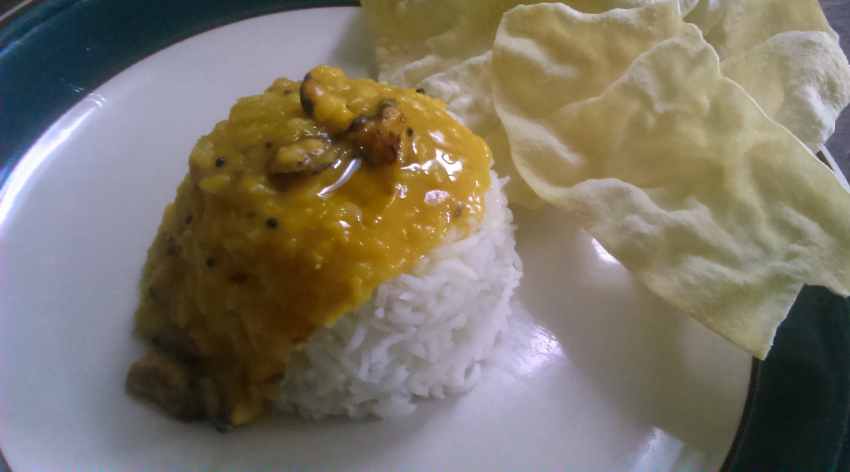
Photograph by Sai Raje
Nothing says home to me like ambatvaran-bhaat, a spicy-sour dal with a burnt garlic fodni (tempering), ladled over steamed rice. My mother Shamala cooked it at least twice a week at dinnertime, and I remember all too well the way it was made, the way I waited for it, and the satisfaction of eating it with rice topped with homemade ghee. For my mother, who worked in downtown Mumbai, it was a quick nourishing meal to put on the table as soon as she got back from work to our home, in Thane, before her child dozed off on an empty stomach (I could never stay awake beyond 7.45pm).
The first thing she did after she got home was set up the trusty pressure cooker on the stove with a pan each of rice and tur dal inside it. She would get other chores out of the way, while I kept count of the pressure-cooker whistles. Two whistles for rice; three for rice and dal. The cooked dal would be mashed with spices, jaggery, and tamarind pulp, and water added to thin it to the right consistency. It would then be set on the stove again to simmer, while she got the fodni ready. Watching the fodni build up flavour one spice at a time amid much popping and crackling was the most exciting part of the wait. The oil in the small, cast iron fodni pot had to be hot but not smoking. Mustard seeds and crushed garlic cloves went in first. As they popped, sizzled, and browned, asafoetida and cumin seeds were added to finish the fiery fodni, which was then poured into the dal.
Aai would first serve me some steaming rice. While she reached out for the ambatvaran, I would look over my plate and wait, enjoying the sensation as the swirling steam from the rice caressed my 6-year-old face. Once she had spooned the dal over the rice, she would top it with a small blob of ghee. The satisfaction of tucking into the first few mouthfuls of ambatvaran-bhaat was a unique joy. Being exceedingly hungry and sleepy, it was just the thing to douse the fire in my tummy at the end of a weary day.
Curiously enough, my family never had a written recipe despite ambat varan being a dish exclusive to the Chandraseniya Kayastha Prabhu (CKP) community I was born into. It was only after my grandmother had her cookbook of traditional CKP recipes published over 10 years ago that I began turning to her recipe. Today, it is a firm favourite in my home as well, with even the husband relishing it almost as much as the vengaya sambar he grew up eating. I sometimes feel that, with its ability to envelop you in warmth, ambatvaran-bhaat at dinner is second only to a hug.
Recipe
Ambat varan
Ingredients
½ cup tur dal
¼ tsp turmeric
½ tsp chilli powder
Pinch of asafoetida
1 tbsp chopped jaggery
2 tsps tamarind pulp (or malt or balsamic vinegar)
Salt
For the fodni:
1 tbsp oil
1 tsp mustard seeds
Pinch of asafoetida
2-3 cloves garlic, crushed
1 tsp cumin seeds
Optional: 3-4 curry leaves
Optional garnish: Chopped coriander or a tablespoon of fresh grated coconut.
Method
Soak the tamarind pulp in a little hot water. Press to extract pulp and set aside.
Wash the dal and cover with an inch of water. Add turmeric, asafoetida and pressure cook the dal until soft. Mash the dal; add salt, chilli powder, jaggery and tamarind pulp. Taste the dal to ensure it’s a good balance of spicy, sour and sweet. Add 3/4 cup water to thin the dal, set it in a pan on the stove and let simmer on low heat.
Set the oil on heat in a small, iron kadai or pot. Add crushed garlic and let it brown around the edges. Add mustard seeds. As soon as the mustard pops, add the asafoetida, cumin seeds, and curry leaves if using. Pour the fodni into the dal, stir, and take off the heat as soon as it comes to a boil.
Serve with steamed rice, topped with tuup.









